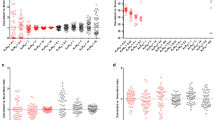Summary
-
1.
A theoretical model of the effects of a saturable removal mechanism for an antagonist diffusing into the receptor compartment of a tissue is used to calculate expected deviations in Schild regressions.
-
2.
At concentrations of antagonist which do not saturate the removal mechanism, there can be a deficit of antagonist in the receptor compartment as compared to the concentration of antagonist bathing the tissue. This results in a shift to the right of the Schild regression and a corresponding underestimation of antagonist potency. The model predicts that as the concentration of antagonist exceeds the K m for removal (saturation of the removal process), this concentration deficit is eliminated, resulting in a proportionate increase in antagonist concentration at the receptor and a concomitant increase in receptor antagonism. This results in a steepening of the Schild regression; the slope in the region of saturation is greater than one.
-
3.
Experimental evidence in support of this model was found in studies of the antagonism of responses to bethanechol by atropine in rabbit ileum; this species is known to have an atropinesterase capable of hydrolyzing atropine. The Schild regression for atropine was curvilinear with an overall slope of 1.42 (1.34–1.5) and pK B = 8.5 (8.36–8.8); in the ileum from guinea pigs, a species which does not possess this enzyme, the Schild regression for atropine was linear, had a slope not significantly different from unity (1.1; 0.95–1.2) and a pK b of 9.0 (8.9–9.2).
-
4.
The slope of the regression in rabbit ileum was corrected to unity by the addition of an excess concentration of methylbutyrate, an alternate substrate for atropinesterase.
-
5.
Experimental factors such as rate of permeation of drug into the receptor compartment, avidity of removal, the effects of unstirred layers and geometrical configuration of tissues are discussed with reference to the expected verisimilitude of the predictions of the model to experimental results.
Similar content being viewed by others
References
Ambache N (1955) The use and limitations of atropine for pharmacological studies on autonomic effectors. Pharmacol Rev 7:467–500
Ammon R, Savelsberg W (1949) Die enzymatische Spaltung von Atropin, Cocain and chemisch verwandten Estern. Zt Physiol Chem 284:135–156
Armitage P (1980) Statistical methods in medical research. Blackwell Scientific Publications, Oxford London Edinburgh
Arunlakshana O, Schild HO (1959) Some quantitative uses of drug antagonists. Br J Pharmacol 14:48–58
Barry PH, Diamond JM (1984) Effects of unstirred layers on membrane phenomena. Physiol Rev 64:763–872
Bernheim F, Bernheim MLC (1938) The hydrolysis of homatropine and atropine by various tissues. J Pharmacol Exp Ther 64:209–216
Ebner F (1981) The positive inotropic effect of (−)-noradrenaline and (±)-isoprenaline after chemical sympathectomy: Evidence in favour of differences at a postsynaptic site. Naunyn-Schmiedeberg's Arch Pharmacol 316:8–18
Ebner F, Wand DR (1978) The role of uptake of noradrenaline for its positive inotropic effect in relation to muscle geometry. Naunyn-Schmiedeberg's Arch Pharmacol 316:96–107
Furchgott RF (1972) The classification of adrenoceptors (adrenergic receptors). An evaluation from the standpoint of receptor theory. In: Blaschko H, Muscholl E (eds) Handbook of Exp Pharmacol, Catecholamines, vol 33. Springer, Berlin Heidelberg New York, pp 283–335
Furchgott RF, Jurkiewitz A, Jurkiewicz NH (1973) Antagonism of propranolol to isoprotrenol in guinea-pig trachea: Some cautionary findings. In: Usdin E, Snyder SH (eds) Frontiers in catecholamine research. Pergamon Press Inc, Elmsford New York, pp 295–300
Glick D, Glaubach S (1941) The occurrence and distribution of atropinesterase and the specificity of atropinesterases. J Gen Physiol 25:197–205
Green AL (1976) The kinetics of enzyme action and inhibition in intact tissues and tissue slices, with special reference to cholinesterase. J Pharma Pharmacol 28:265–274
Guimaraes S, Trendelenburg U (1985) Deviation supersensitivity and inhibition of saturable sites of loss. Trends Pharmacl Sci 6:371–374
Moog P, Krisch K (1974) Versuche zur Reinigung und Charakterisierung der Atropinesterase aus Kaninchenlebermikrosomen. Hoppe-Seyler's Z Physiol Chem 355:529–542
Page E, Bernstein RS (1964) Cat heart muscle in vitro. V. Diffusion through a sheet of right ventricle. J Gen Physiol 47:1129–1140
Snedecor GW, Cochran WG (1967) Statistical methods. Iowa State University Press, Ames, Iowa
Trendelenburg U (1972) Supersensitivity in peripheral organs. In: Pepeu G, Kuhar MJ, Enna SJ (eds) Receptors for neurotransmitters and peptide hormones, vol 21. Raven Press, New York, pp 99–105
Van Rossum JM (1963) Cumulative dose-response curves. II. Technique for the making of dose-response curves in isolated organs and the evaluation of drug parameters. Arch Int Pharmacodyn Ther 143:299–330
Waud DR (1969) A quantitative model for the effect of a saturable uptake on the slope of the dose-response curve. J Pharmacol Exp Ther 167:140–141
Author information
Authors and Affiliations
Rights and permissions
About this article
Cite this article
Kenakin, T.P., Beek, D. The effects on Schild regressions of antagonist removal from the receptor compartment by a saturable process. Naunyn-Schmiedeberg's Arch Pharmacol 335, 103–108 (1987). https://doi.org/10.1007/BF00177709
Received:
Accepted:
Issue Date:
DOI: https://doi.org/10.1007/BF00177709




